The CaO Enhanced Defluorination and Air-Jet Separation of Cathode-Active Material Coating for Direct Recycling Li-Ion Battery Electrodes
Abstract
1. Introduction
- (i)
- Lack of flexible automatic LIB sorting and disassembling technologies allowing the processing of various types of EV LIB modules and cells.
- (ii)
- Absence of sustainable industry-approved automatic large-scale separation of active material coating and foil from LIB electrode.
- (iii)
- The relatively low purity of recycled materials diminishes the quality of re-synthesized active materials, resulting in the application of additional separation (flotation and other) processing steps.
- (iv)
- Application of relithiation technologies with low productivity and without control of the technology parameters.
2. Materials and Methods
3. Results
3.1. Defluorination Examination
- The slight weight loss of 1–1.5% at the temperature range of 50 to 230 °C is ascribed to the volatilization of the electrolyte and the adsorbed water (volatilization stage).
- The weight loss of about 6.0–8.0% at the temperature range of 250 and 600 °C, which is ascribed to the decomposition of PVDF in the spent LIB cathode and the formation of volatile small molecular weight compounds such as vinylidene fluoride (decomposition stage) [11].
3.2. Air-Jet Separation Technology Examination
4. Discussion
4.1. Defluorination
4.2. Air-Jet Separation Technology
4.3. Defluorination Reactor
- ○
- horizontal metal wire mesh conveyors, which are a cost-effective solution for efficient transport of the spent LIB electrodes,
- ○
- two air-jet De-Laval guns for stripping of calcined active material,
- ○
- cyclone collector for collecting the processed active material and
- ○
- filtering unit.
5. Conclusions
Author Contributions
Funding
Data Availability Statement
Acknowledgments
Conflicts of Interest
References
- Wei, G.; Liu, Y.; Jiao, B.; Chang, N.; Wu, M.; Liu, G.; Lin, X.; Weng, X.; Chen, J.; Zhang, L.; et al. Direct recycling of spent Li-ion batteries: Challenges and opportunities toward practical applications. iScience 2023, 26, 107676. [Google Scholar] [CrossRef]
- Yang, Y.; Huang, G.; Xu, S.; He, Y.; Liu, X. Thermal treatment process for the recovery of valuable metals from spent lithium-ion batteries. Hydrometallurgy 2016, 165, 390–396. [Google Scholar] [CrossRef]
- Cui, K.; Zhao, M.-C.; Li, Y.; Atrens, A.; Zhang, F. Recycling of spent lithium iron phosphate batteries: Research progress based on environmental protection and sustainable development technology. Sep. Purif. Technol. 2025, 354, 128982. [Google Scholar] [CrossRef]
- Wang, M.; Tan, Q.; Liu, L.; Li, J. A Facile, Environmentally Friendly, and Low-Temperature Approach for Decomposition of Polyvinylidene Fluoride from the Cathode Electrode of Spent Lithium-ion Batteries. ACS Sustain. Chem. Eng. 2019, 7, 12799–12806. [Google Scholar] [CrossRef]
- Li, J.; Lai, Y.; Zhu, X.; Liao, Q.; Xia, A.; Huang, Y.; Zhu, X.; Li, J.; Lai, Y.; Zhu, X.; et al. Pyrolysis kinetics and reaction mechanism of the electrode materials during the spent LiCoO2 batteries recovery process. J. Hazard. Mater. 2020, 398, 122955. [Google Scholar] [CrossRef] [PubMed]
- Zhao, Y.; Liu, B.; Zhang, L.; Guo, S. Microwave-absorbing properties of cathode material during reduction roasting for spent lithium-ion battery recycling. J. Hazard. Mater. 2020, 384, 121487. [Google Scholar] [CrossRef] [PubMed]
- Xiao, Y.; Su, J.; Chen, L. Resonant Acoustic Vibration-Assisted Cathode Stripping for Efficient Recycling of Spent Li-Ion Batteries. J. Manuf. Sci. Eng. 2024, 146, 044501. [Google Scholar] [CrossRef]
- Zambrano-Cruzatty, L.; Yerro, A.; Charbonneau, B.R.; Stark, N. Charbonneau, Nina Stark. A soil mechanics model to determine the onset of wind erosion. Coast. Eng. 2024, 191, 104523. [Google Scholar] [CrossRef]
- Maev, R.G.; Leshchynsky, V. Cold Gas Dynamic Spray; CRC Press: Boca Raton, FL, USA, 2016; p. 300. [Google Scholar]
- ASTM D905-08; Standard Test Method for Strength Properties of Adhesive Bonds in Shear by Compression Loading. ASTM International: West Conshohocken, PA, USA, 2021.
- Tao, R.; Xing, P.; Li, H.; Cun, Z.; Wang, C.; Ma, S.; Sun, Z. Kinetics study and recycling strategies in different stages of full-component pyrolysis of spent LiNixCoyMnzO2 lithium-ion batteries. Waste Manag. 2023, 155, 8–18. [Google Scholar] [CrossRef] [PubMed]
- Zhong, X.; Liu, W.; Han, J.; Jiao, F.; Qin, W.; Liu, T. Pretreatment for the recovery of spent lithium-ion batteries: Theoretical and practical aspects. J. Clean. Prod. 2020, 263, 121439. [Google Scholar] [CrossRef]
- Wang, H.; Liu, J.; Bai, X.; Wang, S.; Yang, D.; Fu, Y.; He, Y. Separation of the cathode materials from the Al foil in spent lithium-ion batteries by cryogenic grinding. Waste Manag. 2019, 91, 89–98. [Google Scholar] [CrossRef] [PubMed]
- Wang, M.; Liu, K.; Yu, J.; Zhang, Q.; Zhang, Y.; Valix, M.; Tsang, D.C. Challenges in Recycling Spent Lithium-Ion Batteries: Spotlight on Polyvinylidene Fluoride Removal. Glob. Chall. 2023, 7, 2200237. [Google Scholar] [CrossRef] [PubMed]
- Tanii, T.; Tsuzuki, S.; Honmura, S.; Kamimura, T.; Sasaki, K.; Yabuki, M.; Nishida, K. Method for Crushing Cell. U.S. Patent No. 6,524,737 B1, 25 February 2003. [Google Scholar]
- Sun, L.; Qiu, K. Vacuum pyrolysis and hydrometallurgical process for the recovery of valuable metals from spent lithium-ion batteries. J. Hazard. Mater. 2011, 194, 378–384. [Google Scholar] [CrossRef]
- Hanisch, C.; Loellhoeffel, T.; Diekmann, J.; Markley, K.J.; Haselrieder, W.; Kwade, A. Recycling of lithium-ion batteries: A novel method to separate coating and foil of electrodes. J. Clean. Prod. 2015, 108, 301–311. [Google Scholar] [CrossRef]
- Ganter, M.J.; Landi, B.J.; Babbitt, C.W.; Anctil, A.; Gaustad, G. Cathode refunctionalization as a lithium ion battery recycling alternative. J. Power Sources 2014, 256, 274–280. [Google Scholar] [CrossRef]
- Sunil, S.R.; Dhawan, N. Thermal Processing of Spent Li-Ion Batteries for Extraction of Lithium and Cobalt–Manganese Values. Trans. Indian Inst. Met. 2019, 72, 3035–3044. [Google Scholar] [CrossRef]
- Jiang, S.-Q.; Nie, C.-C.; Shi, S.-X.; Zhao, Y.-Q.; Li, X.-G.; Deng, C.-Z.; Yang, L.; Zhang, L.; Zhu, X.-N. Enhancements of dissociation of electrode materials in spent lithium-ion batteries by low-temperature heating pretreatment. Process Saf. Environ. Prot. 2023, 170, 908–920. [Google Scholar] [CrossRef]
- Heydari, M.; Rahman, M.; Gupta, R. Kinetic Study and Thermal Decomposition Behavior of Lignite Coal. Int. J. Chem. Eng. 2015, 2015, 481739. [Google Scholar] [CrossRef]
- Huang, H.; Liu, C.; Sun, Z. Transformation and migration mechanism of fluorine-containing pollutants in the pyrolysis process of spent lithium-ion battery. J. Hazard. Mater. 2022, 435, 128974. [Google Scholar] [CrossRef]
- Dey, A.; Gogate, P.R.; Gote, Y.M. A review on ultrasound assisted synthesis of metal oxide and doped metal oxide nanocatalysts and subsequent application as photocatalyst for dye degradation. Environ. Qual. Manag. 2023, 33, 139–163. [Google Scholar] [CrossRef]
- Tao, R.; Xing, P.; Li, H.; Wu, Y.; Li, S.; Sun, Z. Full-Component Pyrolysis Coupled with Reduction of Cathode Material for Recovery of Spent LiNixCoyMnzO2 Lithium-Ion Batteries. ACS Sustain. Chem. Eng. 2021, 9, 6318–6328. [Google Scholar] [CrossRef]
- Ulian, G.; Valdrè, G. High pressure and high temperature behaviour of alkali-halide fluorite CaF2 for technological applications. Comput. Mater. Sci. 2024, 244, 113176. [Google Scholar] [CrossRef]
- Feng, D.; Zhu, Y.; Li, F.; Li, Z. Influence investigation of CaF2 on the LAS based glass-ceramics and the glass-ceramic/diamond composites. J. Eur. Ceram. Soc. 2016, 36, 2579–2585. [Google Scholar] [CrossRef]
- Synowiec, P.M.; Stec, M. Analysis of CaF2 Precipitation Process in the Selected Static Mixers. Hindawi J. Chem. 2019, 2019, 6728492. [Google Scholar] [CrossRef]
- Lacson, C.F.Z.; Lu, M.-C.; Huang, Y.-H. Chemical precipitation at extreme fluoride concentration and potential recovery of CaF2 particles by fluidized-bed homogenous crystallization process. Chem. Eng. J. 2021, 415, 128917. [Google Scholar] [CrossRef]
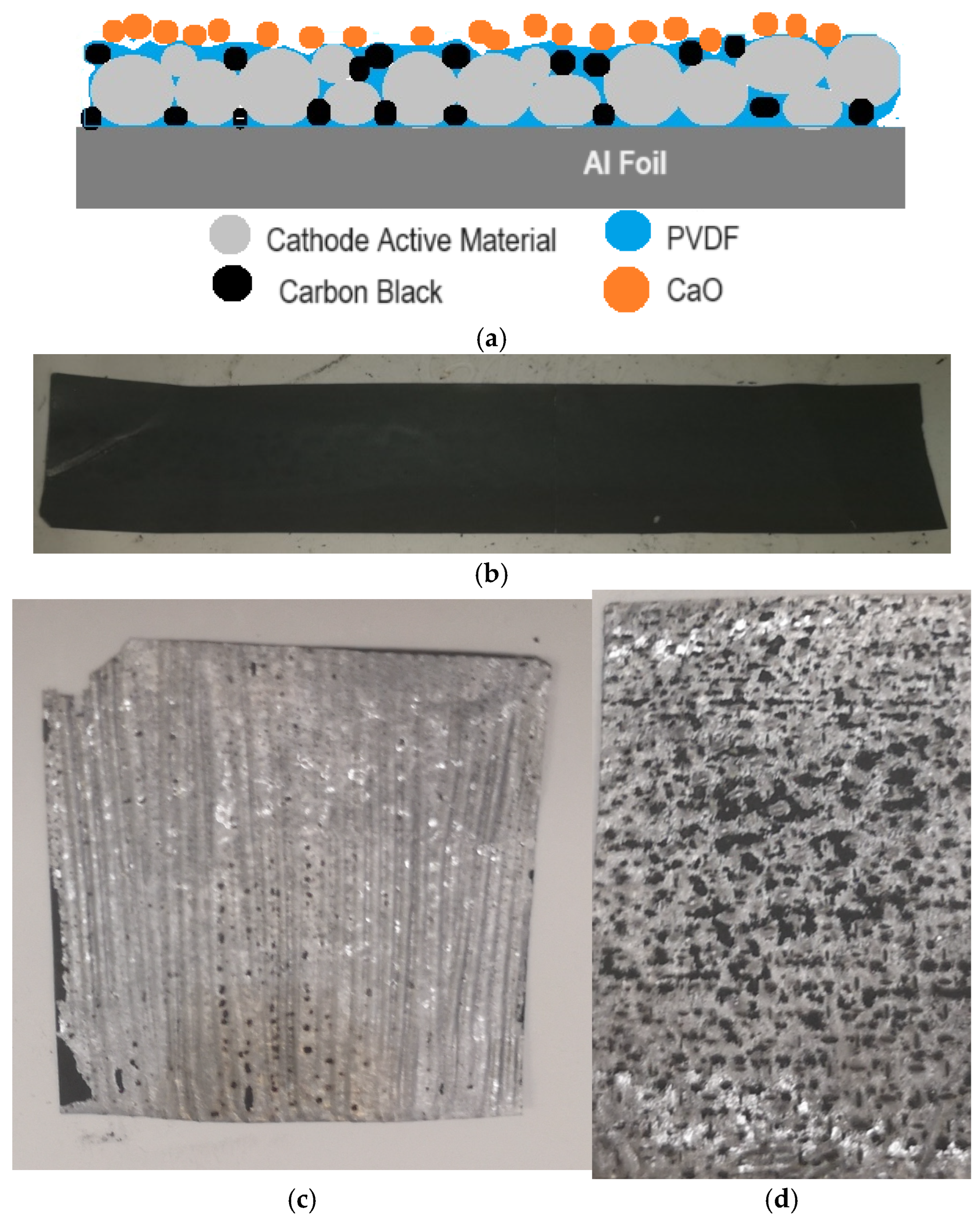
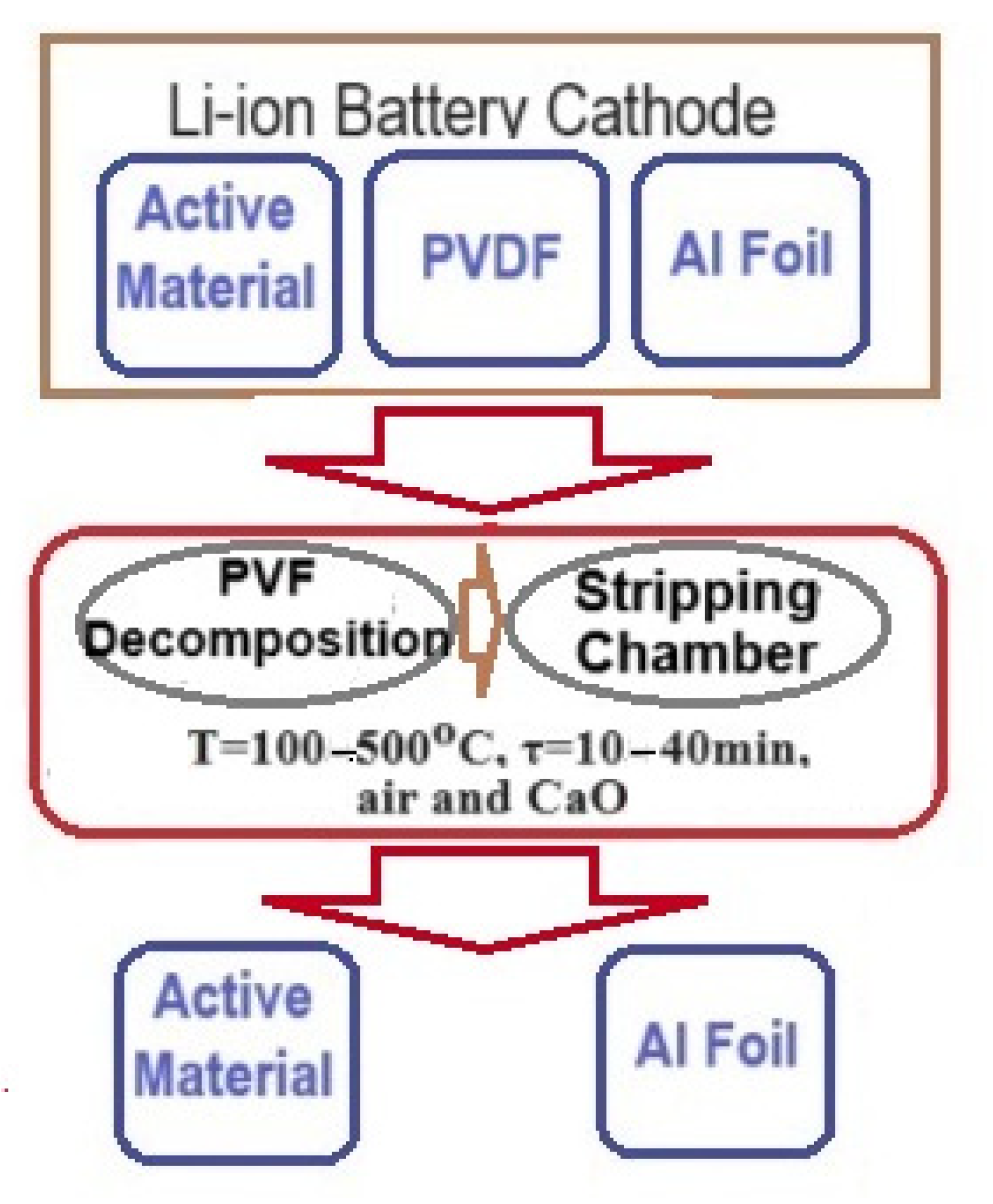


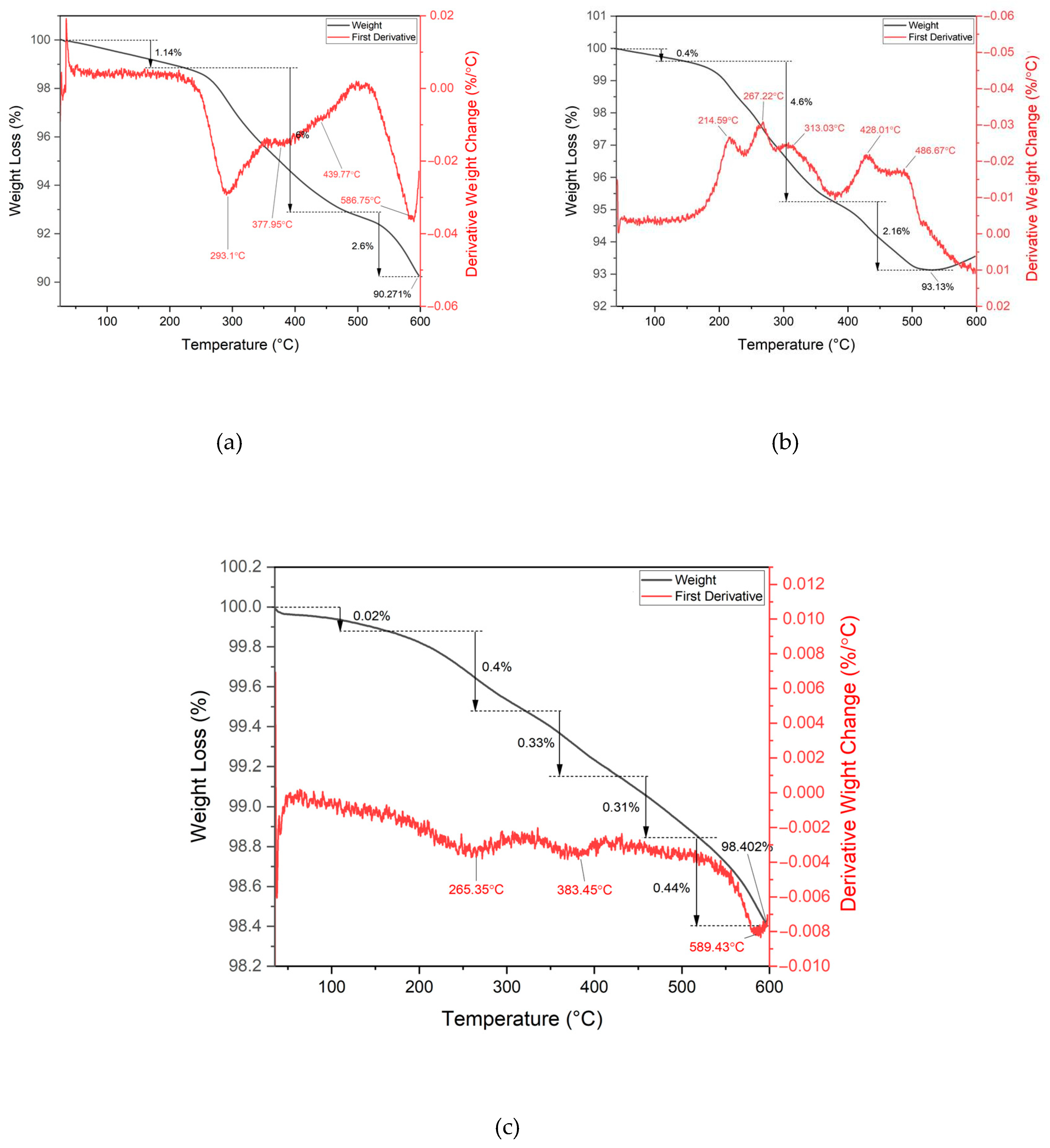
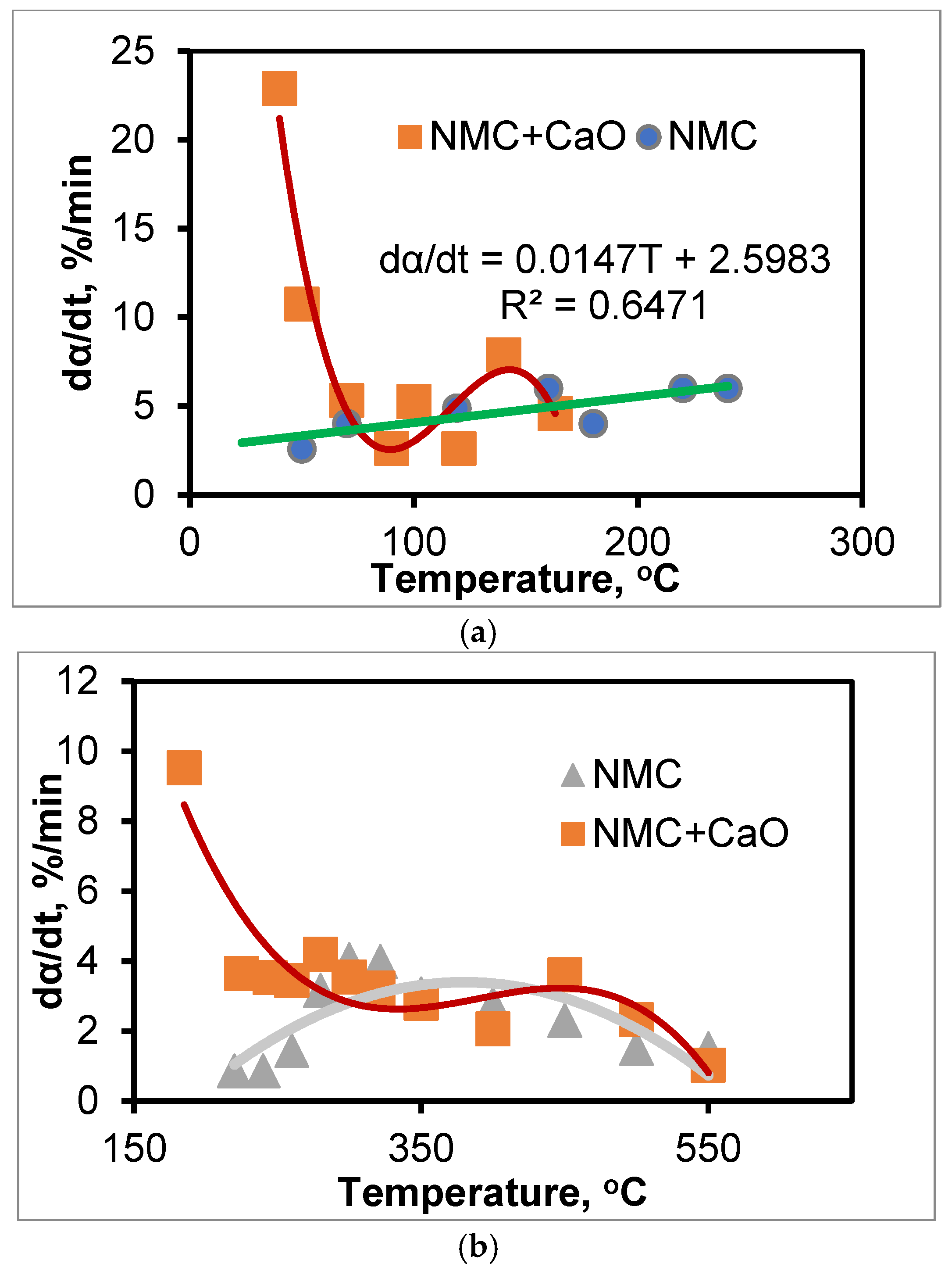
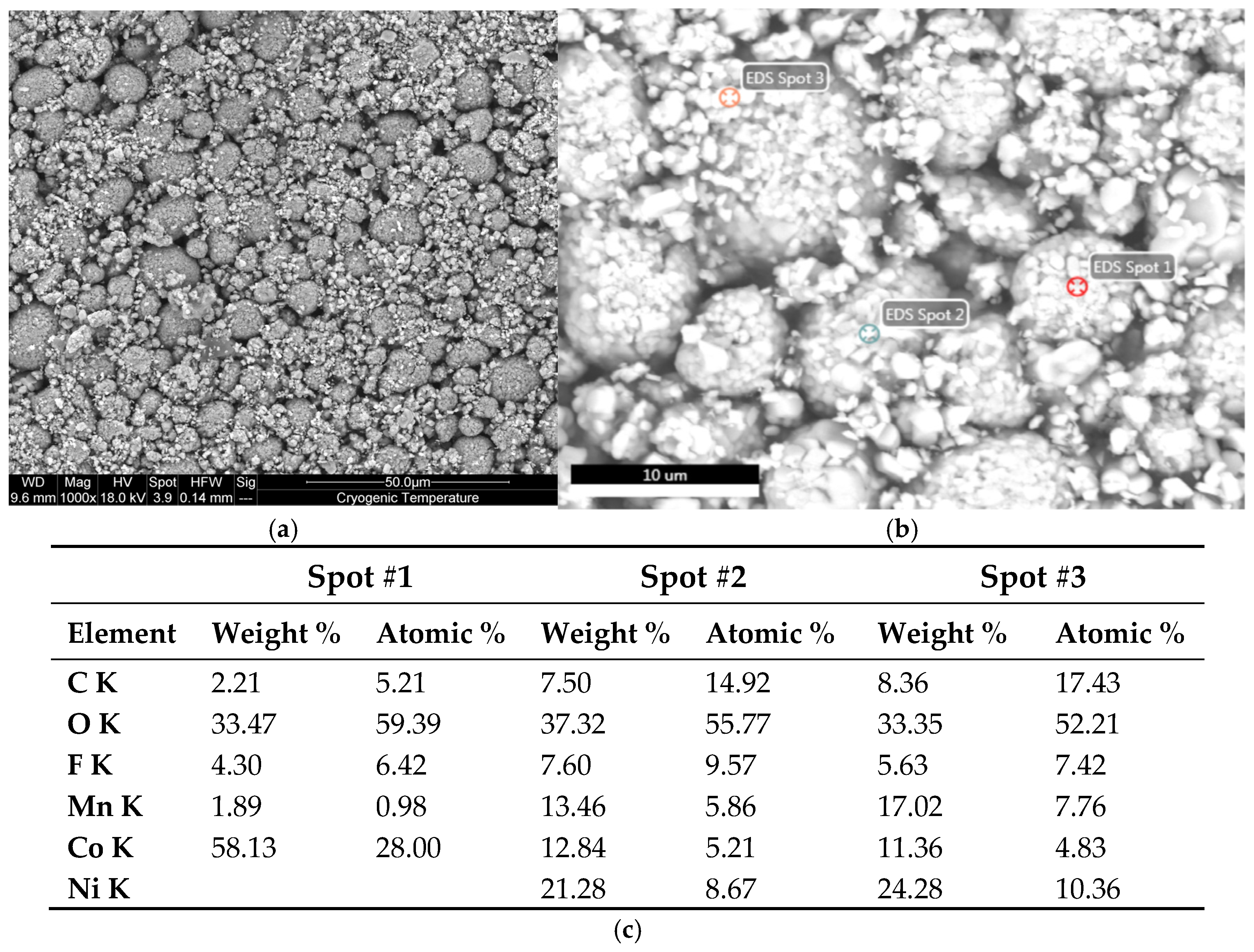
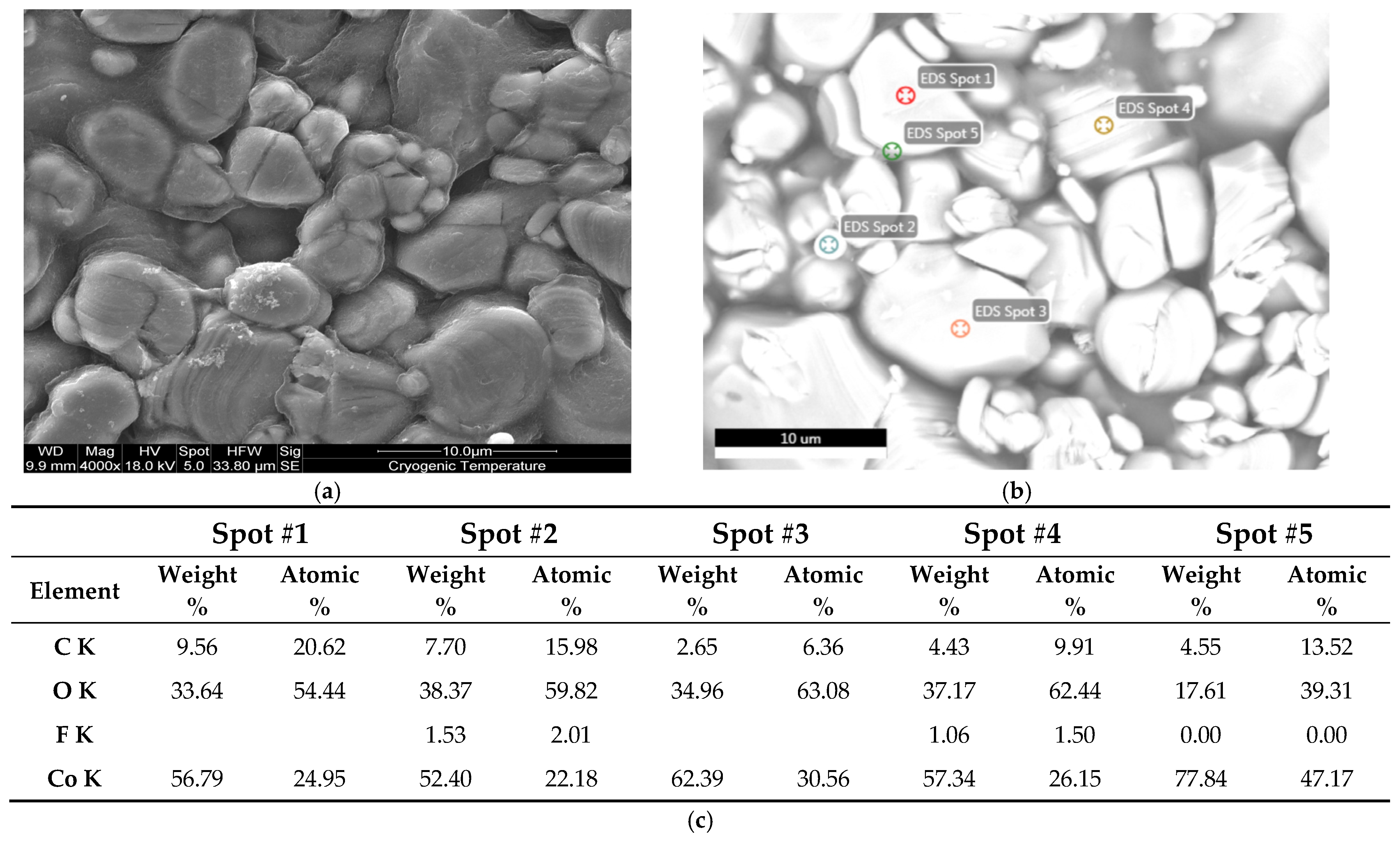
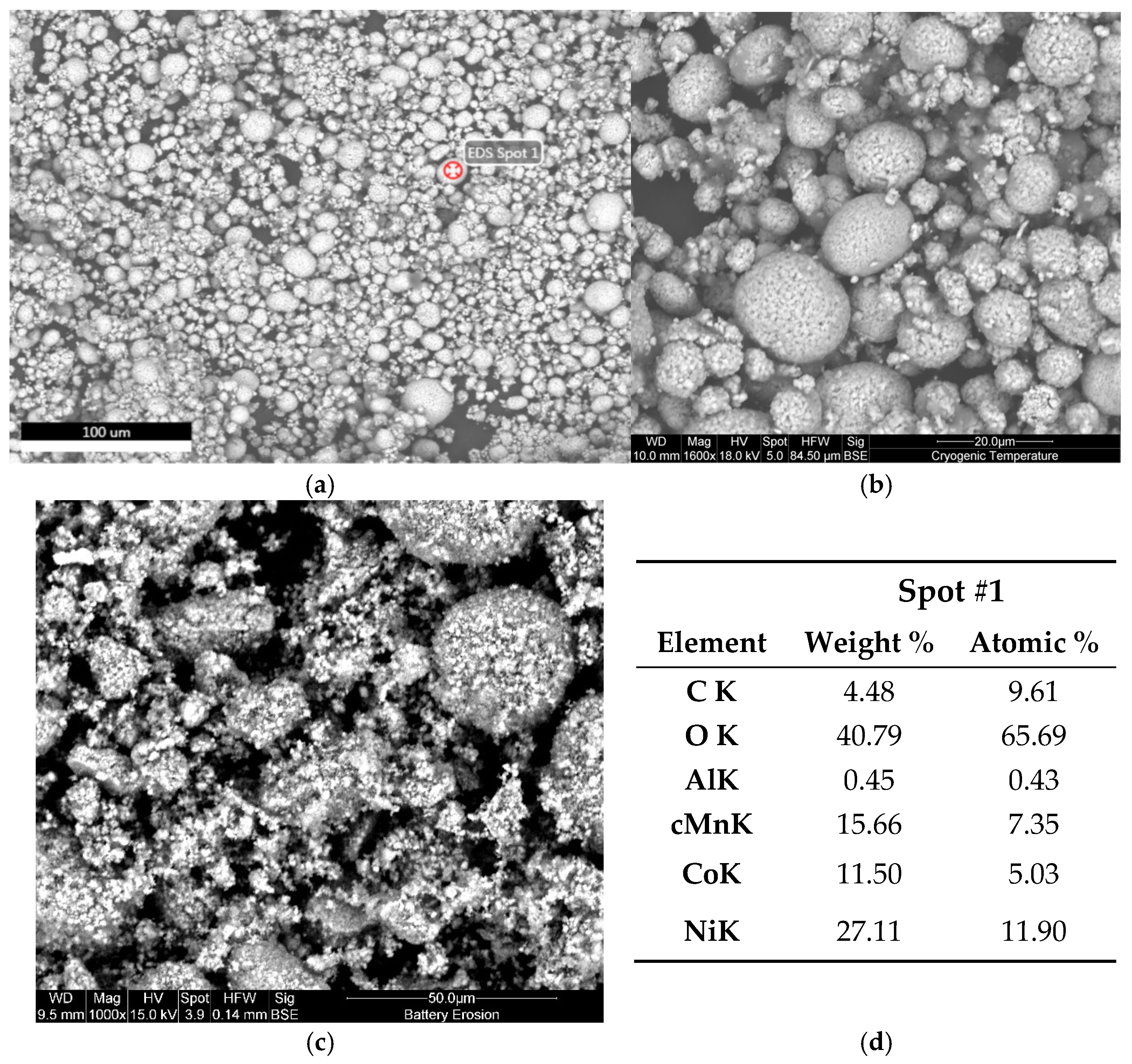

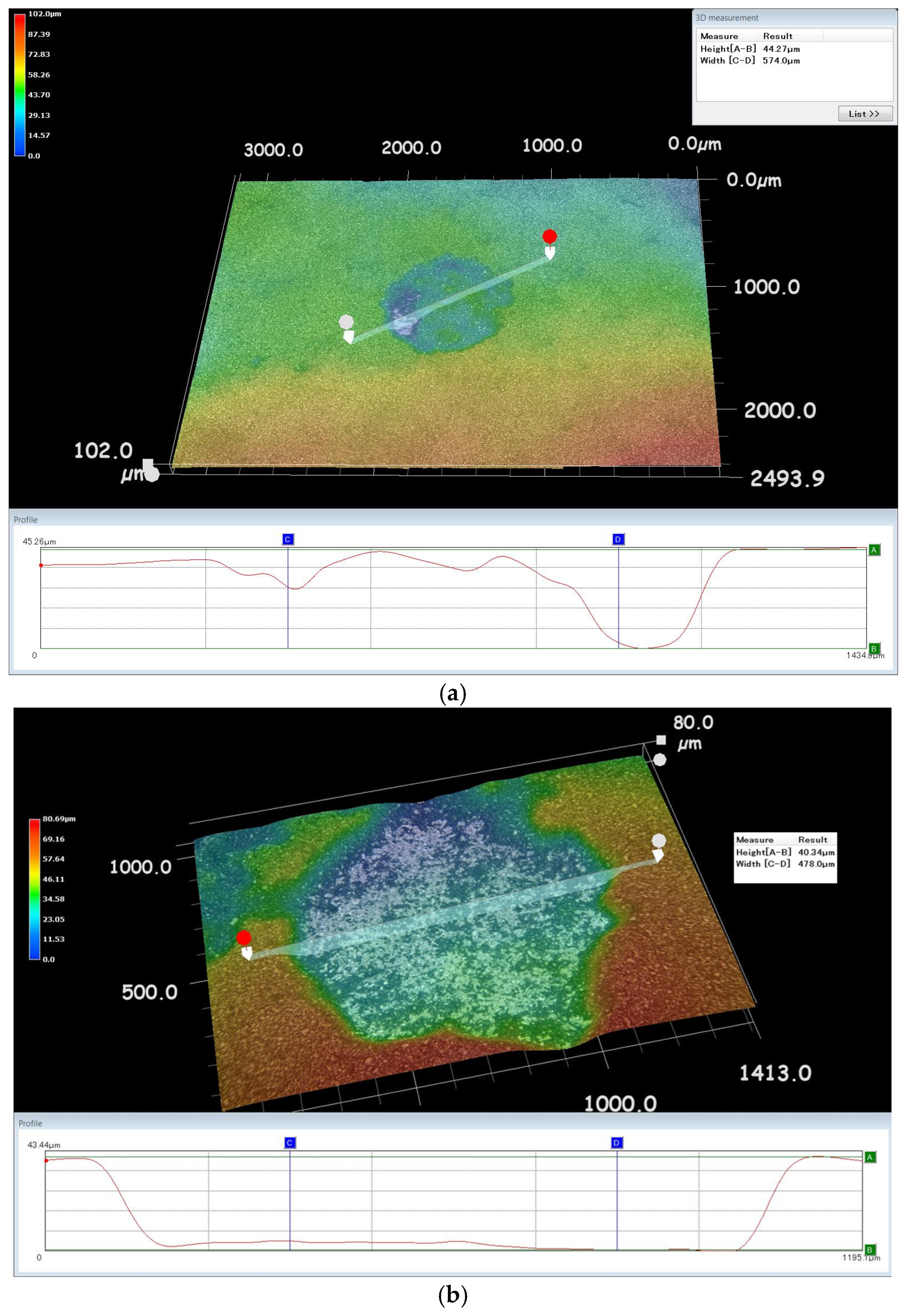


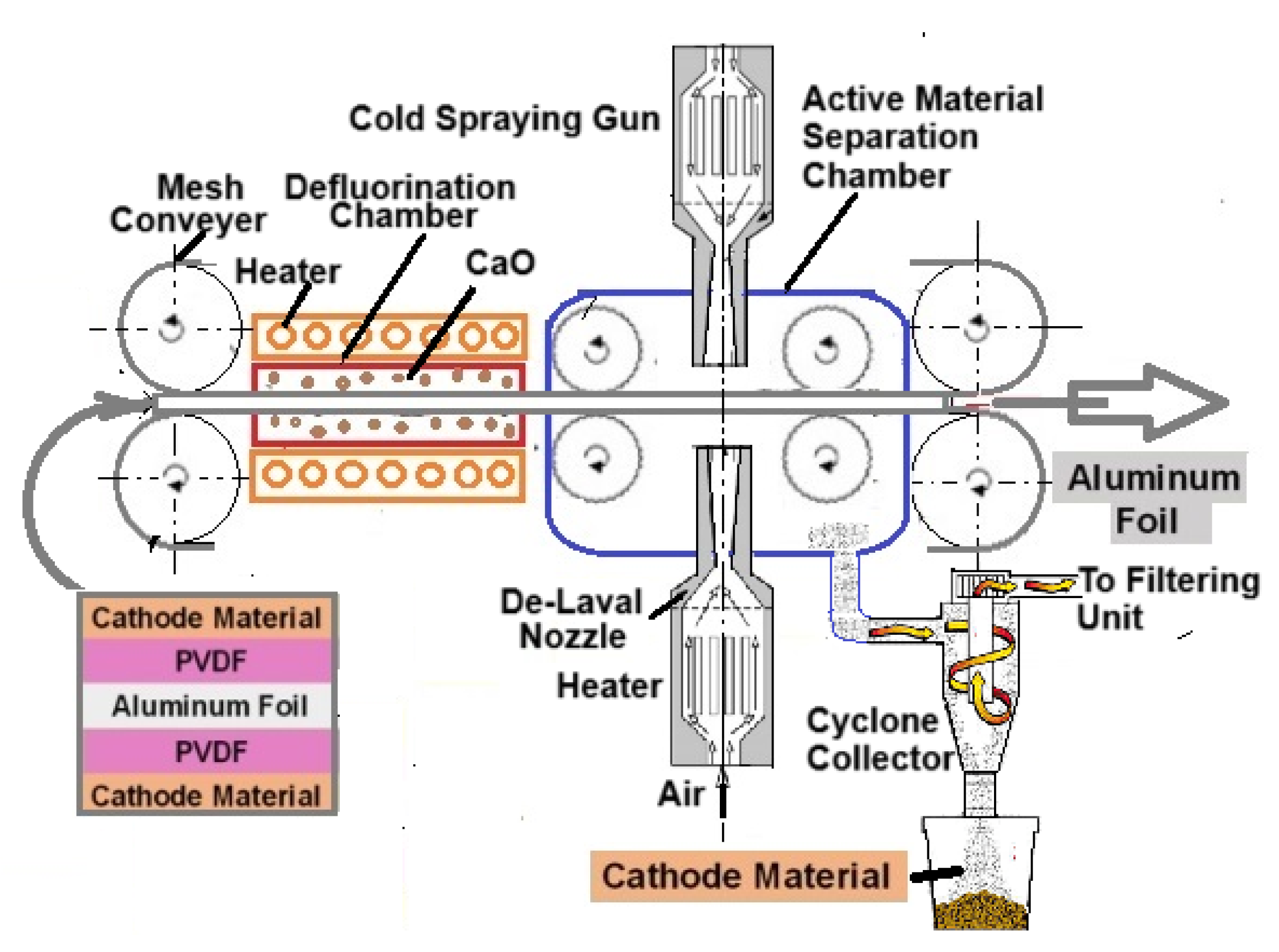
Disclaimer/Publisher’s Note: The statements, opinions and data contained in all publications are solely those of the individual author(s) and contributor(s) and not of MDPI and/or the editor(s). MDPI and/or the editor(s) disclaim responsibility for any injury to people or property resulting from any ideas, methods, instructions or products referred to in the content. |
© 2024 by the authors. Licensee MDPI, Basel, Switzerland. This article is an open access article distributed under the terms and conditions of the Creative Commons Attribution (CC BY) license (https://creativecommons.org/licenses/by/4.0/).
Share and Cite
Siwak, P.; Leshchynsky, V.; Strumban, E.; Pantea, M.; Garbiec, D.; Maev, R. The CaO Enhanced Defluorination and Air-Jet Separation of Cathode-Active Material Coating for Direct Recycling Li-Ion Battery Electrodes. Metals 2024, 14, 1466. https://doi.org/10.3390/met14121466
Siwak P, Leshchynsky V, Strumban E, Pantea M, Garbiec D, Maev R. The CaO Enhanced Defluorination and Air-Jet Separation of Cathode-Active Material Coating for Direct Recycling Li-Ion Battery Electrodes. Metals. 2024; 14(12):1466. https://doi.org/10.3390/met14121466
Chicago/Turabian StyleSiwak, Piotr, Volf Leshchynsky, Emil Strumban, Mircea Pantea, Dariusz Garbiec, and Roman Maev. 2024. "The CaO Enhanced Defluorination and Air-Jet Separation of Cathode-Active Material Coating for Direct Recycling Li-Ion Battery Electrodes" Metals 14, no. 12: 1466. https://doi.org/10.3390/met14121466
APA StyleSiwak, P., Leshchynsky, V., Strumban, E., Pantea, M., Garbiec, D., & Maev, R. (2024). The CaO Enhanced Defluorination and Air-Jet Separation of Cathode-Active Material Coating for Direct Recycling Li-Ion Battery Electrodes. Metals, 14(12), 1466. https://doi.org/10.3390/met14121466






